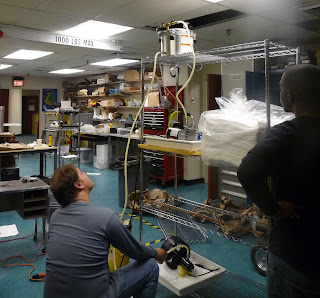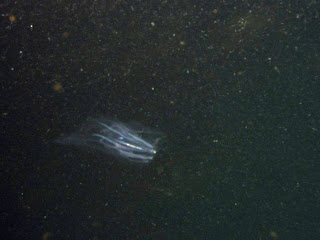Here's our first day of deployments in 2010, as told in pictures:
First Day of Deployment, 2010
Thursday, June 3, 2010
Posted by Ian at 10:50 PM
Labels: field operations
Compass Error Calculation
Friday, April 16, 2010

The results are in, and the compass did not do well. If the compass was reading correctly, then even with some level of error in each measurement we should see no trends.
These do not appear to be random errors. We will have to try this again with another INS and see if we get a similar result.
Posted by Ian at 4:15 PM 0 comments
Labels: ins
Compass Error Measurement
Wednesday, April 14, 2010

Today we started investigating a possible error in our compass measurements by recording the INS heading and GPS coordinates. Basically, we mounted the INS and GPS on a piece of plywood, hooked up a laptop and car battery, and threw the whole setup into a non-ferrous plastic radio flyer wagon.
This is the path recorded by the GPS as we went around and across the football field. The goal was to get data in as many directions as possible, but long enough runs in each direction so that we'd get good averages.
Interactive AUV Mission Planning with Google Earth
Monday, April 5, 2010
In winter, we develop.
For best results, watch the HD (720p) version in full screen.
Posted by Ian at 12:37 PM
Labels: google earth
The Search for Didemnum: Day 5 (Now THAT'S More Like It)
Thursday, October 15, 2009
 We got off to a great start!
We got off to a great start!
Clear water, proper bottom type, and great lighting. Today is a day to find didemnum!
 We're no experts on identifying tunicates, but we had no problem finding spectacular examples of sea life amongst the volumes of images that Odyssey brought back.
We're no experts on identifying tunicates, but we had no problem finding spectacular examples of sea life amongst the volumes of images that Odyssey brought back.
This is a sunflower sea star. A skate...
A skate... A flounder, doing a good job of blending in...
A flounder, doing a good job of blending in... A tiny solaster (literally, a sun star)...
A tiny solaster (literally, a sun star)... After taking a few thousand pictures, we decided to seek out more rocky bottomed waters by moving further east.
After taking a few thousand pictures, we decided to seek out more rocky bottomed waters by moving further east.
Our recovery was complicated by the rocking of the boat, but as a team we are getting used to handling the swinging vehicle. (There were also some good pictures of the water column!)
(There were also some good pictures of the water column!) Our second deployment went very smoothly.
Our second deployment went very smoothly. Unfortunately, the water was far more turbid in our second area of operation. Sponges, anemones, and redfish dominated the images.
Unfortunately, the water was far more turbid in our second area of operation. Sponges, anemones, and redfish dominated the images. The sponges look like potatoes in these images.
The sponges look like potatoes in these images. Although beautiful to look at, anemones are not what we are after.
Although beautiful to look at, anemones are not what we are after. As the light faded, we made our last recovery for the week and prepared to head back.
As the light faded, we made our last recovery for the week and prepared to head back. We had pictures of too many starfish to count, in all shapes and sizes.
We had pictures of too many starfish to count, in all shapes and sizes. This one was hanging out inside a mussel shell. I can't tell if it's eating or just resting.
This one was hanging out inside a mussel shell. I can't tell if it's eating or just resting. There were also quite a few crabs, hermit crabs, and sunflower sea stars.
There were also quite a few crabs, hermit crabs, and sunflower sea stars.
Posted by Ian at 7:26 PM
Labels: camera, field operations, success
Divide and Conquer
Wednesday, October 14, 2009
 While Mike performed a miraculous teardown and rebuild of the vehicle on the deck of the Isabella & Ava,
While Mike performed a miraculous teardown and rebuild of the vehicle on the deck of the Isabella & Ava, 
We met back up late that night.
The Search for Didemnum: Day 4 (One Good Mission, and Downhill From There)
 Today we were accompanied by Rachel from the Northeast Consortium (NEC), the organization responsible for funding this trip.
Today we were accompanied by Rachel from the Northeast Consortium (NEC), the organization responsible for funding this trip.
We decided to survey near the outflow pipe from Boston because we figured that it would be warmer and more likely to sustain didemnum.
Deployment was rough. We immediately lost the vehicle behind the stern and had it pop up near the starboard bow. That can't be good. However, everything seemed to have survived intact, so we started our day of testing. After a few false starts, we ran a survey mission to see if the warmer water from the outflow pipe would make a difference in our images.
However, everything seemed to have survived intact, so we started our day of testing. After a few false starts, we ran a survey mission to see if the warmer water from the outflow pipe would make a difference in our images.
It did... Whether from the pipe or from the gale force winds during the previous night,
Whether from the pipe or from the gale force winds during the previous night, ...the turbidity in the water made for terrible image quality.
...the turbidity in the water made for terrible image quality.  This lobster trap was one of the few recognizable objects in all our photos.
This lobster trap was one of the few recognizable objects in all our photos. Seth had no luck finding any fish, and the sea state didn't help.
Seth had no luck finding any fish, and the sea state didn't help. Jellyfish, on the other hand were found in abundance
Jellyfish, on the other hand were found in abundance throughout
throughout the
the water
water  column.
column. So
So  many
many  jellies!
jellies! We decided to haul up the vehicle to try another location. It was especially difficult with the waves being higher than they were yesterday.
We decided to haul up the vehicle to try another location. It was especially difficult with the waves being higher than they were yesterday.
Odyssey swung quite a bit while we guided it to its cradle.
That's when things got worse.
"We're all done, guys" said Seth.
"What?"


We had been oeprating with slowly-leaking oil all day! Worse, we had no way to refill and re-close the hole; the show was over.
There was no choice but to end the day early and attempt to do some emergency repairs.
Back to the lab!
Posted by Ian at 5:52 PM
Labels: camera, damage report, field operations